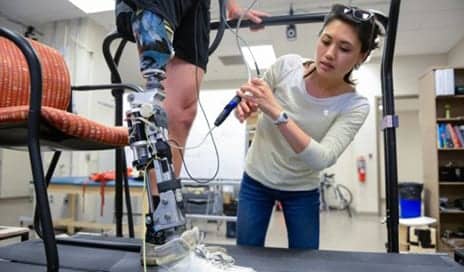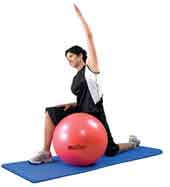
North Carolina State University PhD student Andrea Brandt works to test wearable robotics and how they adapt to weight-bearing loads. (Photo courtesy of Marc Hall, NC State University)
Research conducted at North Carolina State University tested how well wearable robotics for amputees adapt to weight-bearing loads, such as carrying groceries or wearing a backpack.
The results could help device manufacturers and clinicians expands the utility of these devices to help amputees walk, and to help researchers develop smarter controllers that adapt to real-world demands, notes a media release from North Carolina State University.
The study, conducted by Andrea Brandt, a PhD student in the NC State and University of North Carolina-Chapel Hill Joint Department of Biomedical Engineering, was published recently in Scientific Reports.
“We wanted to first understand how load affects amputees walking with normal prosthesis settings that are typically prescribed in the clinic, and then to what degree different settings could benefit them,” Brandt says, in the release.
“The device we tested was a powered knee prosthesis—it has a motor to actuate the knee and a fixed ankle joint. We programmed multiple settings that provided individually tuned mechanics in load-bearing and non-load-bearing conditions. We evaluated both how these settings and how carrying a load would change our study participants’ gait and self-reported exertion rates.”
The study included five people of varied ages and physical attributes. After walking on a lab treadmill with and without a backpack adding 20% of their body weight, and with or without the load-bearing power settings, the study subjects reported having more difficulties when carrying the load with the prosthetic device set at the normal setting.
“Perceived exertion definitely increased, the device would hyperextend, and people relied more on their intact limb, which is already being overused,” Brandt adds, in the release. “Those problems were reduced when the device was set to the load-bearing setting.”
Participants didn’t report many difficulties with either prosthetic setting when not carrying the backpack, according to Brandt.
“Carrying a load makes your muscles contract in different ways that aren’t being mimicked in prostheses today,” Brandt continues. “So we think load-adaptive devices could make an important difference for amputees.
“In the long run, we want prostheses to be smarter and more functional, so amputees can rely on their prosthetic limb more, get more out of it in their daily life, get back to the activities that they love, and potentially prevent the development of secondary health issues—like osteoarthritis and back pain—that develop from having to rely more on their intact side,” Brandt concludes.
[Source(s): North Carolina State University, Science Daily]




